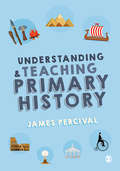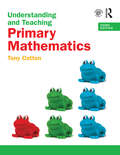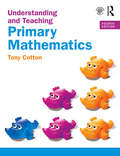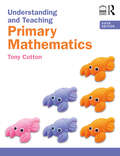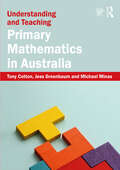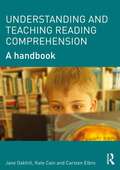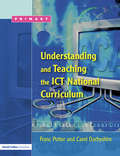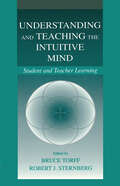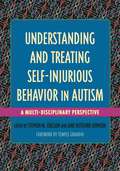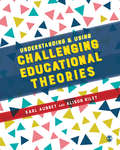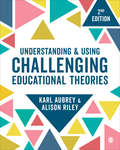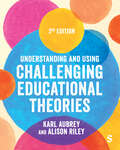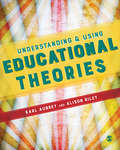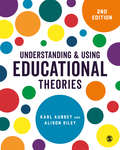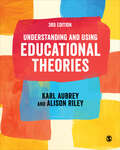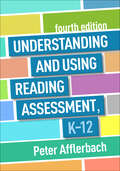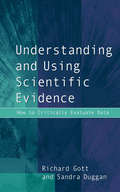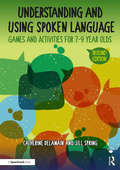- Table View
- List View
Understanding and Teaching Primary History
by James PercivalPrimary history is one of the richest areas of teaching and learning, but in order to teach it well you need a strong understanding of key historical concepts and the content of the national curriculum. Combining a detailed focus on the core skills and principles underpinning good history teaching, this book will help you to: · appreciate the key concepts that underpin historical understanding · engage deeply with the programmes of study for Key Stage 1 and 2 · understand the links between historical reasoning and constructivist accounts of how children learn · apply a cross-curricular approach to your teaching · assess children’s historical understanding
Understanding and Teaching Primary History
by James PercivalPrimary history is one of the richest areas of teaching and learning, but in order to teach it well you need a strong understanding of key historical concepts and the content of the national curriculum. Combining a detailed focus on the core skills and principles underpinning good history teaching, this book will help you to: · appreciate the key concepts that underpin historical understanding · engage deeply with the programmes of study for Key Stage 1 and 2 · understand the links between historical reasoning and constructivist accounts of how children learn · apply a cross-curricular approach to your teaching · assess children’s historical understanding
Understanding and Teaching Primary Mathematics
by Tony CottonWritten by an education consultant with widespread experience of teaching mathematics in the UK and internationally, Understanding and Teaching Primary Mathematics seamlessly combines pedagogy and subject knowledge to build confidence and equip you with all the skills and know-how you need to successfully teach mathematics to children of any age. This 3rd edition has been fully updated to reflect the latest research developments and initiatives in the field, as well as key changes to both the UK National Curriculum and International Baccalaureate, including a brand new chapter on 'Algebra' and a reworked focus on the early years. Extra features also include helpful call-outs to the book's revised and updated companion website, which offers a shared site with a range of resources relevant to both this book and its new companion volume, Teaching for Mathematical Understanding. Stimulating, accessible and well-illustrated, with comprehensive coverage of subject knowledge and pedagogy, Understanding and Teaching Primary Mathematics is an essential purchase for trainee and practising teachers alike. Companion website features new to this edition include: video clips in which the author demonstrates the concepts covered in the book through teaching to a real class PowerPoint presentations which provide support for those using the book as a part of a teacher training course updated weblinks to external sites with useful teaching information and resources
Understanding and Teaching Primary Mathematics
by Tony CottonWritten by an experienced teacher and teacher educator with widespread experience of teaching mathematics in the UK and internationally, Understanding and Teaching Primary Mathematics combines pedagogy and subject knowledge to build confidence and equip you with all the skills and know-how you need to successfully teach mathematics to children of any age. This 4th edition has been fully updated to reflect the latest research developments and initiatives in the field, including a brand-new chapter on ‘Mastery and mathematics’ and ‘The Singapore approach’ which reflects the current international interest in these approaches to learning and teaching mathematics. Extra features also include helpful callouts to the book’s revised and updated companion website, which offers a shared site with a range of resources relevant to both this book and its companion volume, Teaching for Mathematical Understanding. Stimulating, accessible and well-illustrated, with comprehensive coverage of subject knowledge and pedagogy, Understanding and Teaching Primary Mathematics is an essential purchase for trainee and practising teachers alike.
Understanding and Teaching Primary Mathematics
by Tony CottonWritten by an experienced teacher and teacher educator with widespread experience of teaching mathematics in the UK and internationally, the bestselling Understanding and Teaching Primary Mathematics combines pedagogy and subject knowledge to build confidence and equip you with all the skills and know-how you need to successfully teach mathematics to children of any age.This fifth edition has been completely updated to include the latest developments in learning and teaching mathematics, including mastery approaches, a Singapore approach and the use of manipulatives in the primary classroom. There are new activities for you to use in your teaching and links to the dedicated website, which contains materials to develop a personal portfolio, more activities to use in your classroom and presentations and podcasts to support your further professional development to reflect the latest research developments. It covers all areas of the mathematics curriculum and will allow you to become a confident teacher of mathematics through developing your own subject knowledge.Tony draws on his many years of experience teaching mathematics and working with early career teachers to share classroom activities which will support you in learning mathematics through engaging in mathematical activity with your learners.
Understanding and Teaching Primary Mathematics in Australia
by Tony Cotton Jess Greenbaum Michael MinasWritten by experienced teacher educator and author, Tony Cotton, and two Australian primary teachers, Jess Greenbaum and Michael Minas, Understanding and Teaching Primary Mathematics in Australia combines pedagogy and mathematics subject knowledge to build teachers’ confidence both in their mathematical subject knowledge and in their ability to teach mathematics effectively. The book covers all the key areas of the Australian Curriculum for mathematics from teaching number and calculation strategies to exploring geometry and statistics. There are also chapters that deal with the teaching of mathematics in the Early Years, inclusive approaches to mathematics teaching and teaching mathematics using ICT. Stimulating, accessible and containing a wealth of practical ideas for use in the classroom, Understanding and Teaching Primary Mathematics in Australia is an essential text for graduate and practicing teachers alike.
Understanding and Teaching Reading Comprehension: A handbook
by Jane Oakhill Kate Cain Carsten ElbroThe ultimate aim of reading is not the process but to understand what we read and comprehension can take place at many different levels. There has been an increasing emphasis on the importance of reading comprehension in recent years but despite this there is very little written on this vital topic accessible to trainee and practicing teachers. The Handbook of Reading Comprehension presents an overview of recent findings on reading comprehension and comprehension problems in children. It provides a detailed examination of the characteristics of children who have reading comprehension difficulties, and examines ways in which comprehension can be supported and improved. It is accessibly written for students and professionals with no previous background in the psychology of reading or reading problems. This indispensable handbook asks the question ‘what is comprehension?’ The authors consider comprehension of different units of language: understanding single words, sentences, and connected prose and outline what readers (and listeners) have to do to successfully understand an extended text. This book also considers comprehension for different purposes, in particular reading for pleasure and reading to learn and explores how reader characteristics such as interest and motivation can influence the comprehension process. Different skills contribute to successful reading comprehension. These include word reading ability, vocabulary knowledge, syntactic skills, memory, and discourse level skills such as the ability to make inferences, knowledge about text structure, and metacognitive skills. The authors discuss how each one contributes to the development of reading comprehension skill and how the development of these skills (or their precursors) in pre-readers, provides the foundation for reading comprehension development. Areas covered include:- Word reading and comprehension Development of comprehension skills Comprehension difficulties Assessment Teaching for improvement Throughout the text successful experimental and classroom based interventions will be highlighted, practical tips for teachers and summary boxes detailing key points and explaining technical terms will be included in each chapter
Understanding and Teaching Reading: An Interactive Model
by Emerald DechantIn the words of Aldous Huxley, "Every man who knows how to read has it in his power to magnify himself, to multiply the ways in which he exists, to make his life full, significant and interesting." Few people question the value of reading; in fact, most extol its virtues. As our culture becomes more complex, reading plays an increasingly greater role in satisfying personal needs and in promoting social awareness and growth. In the last 20 years, the teaching of this invaluable skill has focused so intensely on comprehension and prediction from context that it has lost sight of the significance of automaticity and fluency in the word-identification process. Reading is a synthesis of word recognition and comprehension; thus, this text is about these basic processes and their integration. A common plea from teachers today is that research and psychology be translated into teaching behavior. Therefore, the aim of this book is twofold: one, to identify, report, organize, and discuss those bits of data, research and theory that are most relevant to the teacher's understanding of the reading process; and two, to help educators to interpret and apply theory and research data to everyday classroom teaching, as well as to the problems encountered frequently in developmental and remedial teaching.
Understanding and Teaching the ICT National Curriculum
by Franc PotterThere is still great uncertainty in the teaching profession regarding the effective delivery of ICT. This introductory book provides both trainee and practising teachers with a clear understanding of the ICT National Curriculum and how to teach it. Combining extensive practical advice with a critical discussion of the key theoretical issues, the book will help teachers develop their pupil's true ICT capability through clear explanations of the Programmes of Study, full guidance on using QCA Scheme of Work, different and creative ideas for delivering the ICT National Curriculum, and the confidence and ability to go beyond the QCA Sceme of Work for ICT.
Understanding and Teaching the Intuitive Mind: Student and Teacher Learning (Educational Psychology Series)
by Robert J. Sternberg Bruce TorffThe intuitive mind is a powerful force in the classroom and often an undetected one. Intuitive conceptions--knowledge or knowledge-structures that individuals acquire and use largely without conscious reflection or explicit instruction--sometimes work to facilitate learning in the classroom and other contexts. But learning may also be impeded by intuitive conceptions, and they can be difficult to dislodge as needed. The literatures in psychology and education include a large and diverse body of theory and research on intuitive conceptions, but this work is limited in some respects. This volume contributes in four ways to overcome these limitations. Understanding and Teaching the Intuitive Mind: Student and Teacher Learning: * pulls together diverse theoretical and methodological approaches to the origin, structure, function, and development of intuitive conceptions; * explores a diversity of academic disciplines--paying equal attention not only to mathematics and science, the fields in which intuitive concepts have been studied most extensively, but also to the social sciences, arts, and humanities; * explicitly links theory and research to educational implications and classroom applications; and * focuses not only on students' intuitive conceptions but also on teachers' intuitive beliefs about learning and teaching. Although the viewpoints of the contributors are diverse, they share the belief that educational practices have much to gain by systematic studies of the intuitive learner and teacher. This volume offers state-of-the-art, research-based information and support for psychologists, teacher educators, educational administrators, teachers, prospective teachers, and others who seek to develop educational practices that are cognizant of (and responsive to) the intuitive conceptions of students and teachers.
Understanding and Treating Self-Injurious Behavior in Autism: A Multi-Disciplinary Perspective
by Temple Grandin John Green Nancy O'Hara Manuel F. Casanova Lucy Jane Miller Margaret L. Bauman V. Mark Durand June Groden Cooper R. Woodard Harumi Jyonouchi Paul Millard Hardy Stephen M. Edelson Kelly Mccracken Barnhill Mary Coleman Emily L. Casanova Karen Misher Leslie Weidenman Jane Botsford Johnson Lauren J. Moskowitz Jamie D. Bleiweiss Alexis B. Ritter Caitlin E. WalshSelf-injurious behavior occurs in almost half of those with autism and is one of the most devastating and challenging-to-treat behaviors. There are many different forms of self-injury, such as head banging, hand biting, hair pulling, excessive scratching, and much more. With contributions from the leading experts in research and treatment, the book provides a comprehensive analysis of self-injurious behavior (SIB) in people with Autism Spectrum Disorder (ASD) or related developmental disabilities, and the different methods available to treat them. Medical and behavioral researchers have studied SIB for over 50 years, but many practitioners and parents are still unfamiliar with the wide range of contributing causes and treatment options. Beginning with an explanation of SIB and its various forms, the contributors outline the many possible underlying causes of self-injury, such as seizures, hormonal imbalance in teenagers, gastrointestinal conditions, allergies, and stress, and show how a multi-disciplinary approach when uncovering the causes of self-injury can lead to successful treatment strategies. They explain the treatment options available for SIB, including nutritional, medical, psychiatric, sensory, and behavioral approaches, and show how an integrative approach to treating self-injury may be effective for many individuals. The book will be an invaluable addition to the bookshelves of any practitioner working with people with an ASD or related condition, as well as parents and direct care providers.
Understanding and Using Challenging Educational Theories
by Karl Aubrey Alison RileySome of the most important developments in educational thought have been put forward by theorists who have challenged existing notions about the aims of education and its role in society. But how do these ideas relate to today’s classrooms and how can you use them to improve your own teaching practice? This textbook gives you a clear overview of fifteen thinkers who have offered challenging perspectives on education, including influential sociological thinkers (Bourdieu, Foucault, Mezirow, Bernstein), those who have questioned the orthodoxy on schooling (Holt, Darling-Hammond) and other key names whose writing has helped shaped our views on teaching and learning. Each chapter includes: · practical examples showing how theories can be used to inform classroom teaching · critiques of each theorist exploring opposing viewpoints and the strengths and weaknesses of different ideas · reflective tasks inviting you to apply what you’ve read to your own educational experiences. This is essential reading for anyone on university and school-based initial teacher education courses training to teach in different educational settings, including early years and adult education, or studying education at undergraduate and postgraduate level.
Understanding and Using Challenging Educational Theories
by Karl Aubrey Alison RileySome of the most important developments in educational thought have been put forward by theorists who have challenged existing notions about the aims of education and its role in society. But how do these ideas relate to today’s classrooms and how can you use them to improve your own teaching practice? This textbook gives you a clear overview of fifteen thinkers who have offered challenging perspectives on education, including influential sociological thinkers (Bourdieu, Foucault, Mezirow, Bernstein), those who have questioned the orthodoxy on schooling (Holt, Darling-Hammond) and other key names whose writing has helped shaped our views on teaching and learning. Each chapter includes: · practical examples showing how theories can be used to inform classroom teaching · critiques of each theorist exploring opposing viewpoints and the strengths and weaknesses of different ideas · reflective tasks inviting you to apply what you’ve read to your own educational experiences. This is essential reading for anyone on university and school-based initial teacher education courses training to teach in different educational settings, including early years and adult education, or studying education at undergraduate and postgraduate level.
Understanding and Using Challenging Educational Theories
by Karl Aubrey Alison RileyIntroducing you to 18 key educational thinkers who have offered challenging perspectives on education, this new edition comes with: - 3 new chapters on Ivan Illich, Loris Malaguzzi and Michael Apple - A glossary of key words related to each theorist’s work - A context-setting overview of key themes - Practical examples that shows how theories can be applied to your practice Use this book with it′s companion title Aubrey & Riley, Understanding and Using Educational Theories 2e (9781526436610)
Understanding and Using Challenging Educational Theories
by Karl Aubrey Alison RileyIntroducing you to 18 key educational thinkers who have offered challenging perspectives on education, this new edition comes with: - 3 new chapters on Ivan Illich, Loris Malaguzzi and Michael Apple - A glossary of key words related to each theorist’s work - A context-setting overview of key themes - Practical examples that shows how theories can be applied to your practice Use this book with it′s companion title Aubrey & Riley, Understanding and Using Educational Theories 2e (9781526436610)
Understanding and Using Challenging Educational Theories
by Karl Aubrey Alison RileyIntroducing: 20 key educational thinkers who have offered challenging perspectives on education Exploring: Their ideas, how to apply them in practice and their relevance to teaching and learning today. Understanding: The strengths and limitations of each theory and links to other concepts. This third edition includes: Two new chapters on the works of Diane Ravitch and Gloria Ladson-Billings Revamped reflective tasks with a greater practical focus for the classroom Fully updated chapters with links to current educational socio-political developments, and expanded critical commentary This is an essential textbook for any university course that includes learning theory, with particular relevance for initial teacher education, education studies and early childhood degrees. Karl Aubrey has recently retired from his post at Bishop Grosseteste University. Alison Riley is the Programme Leader for the BA Early Childhood Studies at Bishop Grosseteste University. The perfect companion to Aubrey & Riley: Understanding and Using Educational Theories 3e (9781529761306).
Understanding and Using Challenging Educational Theories
by Karl Aubrey Alison RileyIntroducing: 20 key educational thinkers who have offered challenging perspectives on education Exploring: Their ideas, how to apply them in practice and their relevance to teaching and learning today. Understanding: The strengths and limitations of each theory and links to other concepts. This third edition includes: Two new chapters on the works of Diane Ravitch and Gloria Ladson-Billings Revamped reflective tasks with a greater practical focus for the classroom Fully updated chapters with links to current educational socio-political developments, and expanded critical commentary This is an essential textbook for any university course that includes learning theory, with particular relevance for initial teacher education, education studies and early childhood degrees. Karl Aubrey has recently retired from his post at Bishop Grosseteste University. Alison Riley is the Programme Leader for the BA Early Childhood Studies at Bishop Grosseteste University. The perfect companion to Aubrey & Riley: Understanding and Using Educational Theories 3e (9781529761306).
Understanding and Using Educational Theories
by Karl Aubrey Alison Riley" I expect that this book will equip and inspire students to engage first-hand with the texts of these creative and influential educational writers."-David Aldridge, Programme Lead: Professional Education, Oxford Brookes University If you're training to teach or studying education a clear understanding of major educational theories and the thinkers behind them is essential in order to appreciate how different practices impact on learning. This textbook gives you a clear overview of the most influential twentieth and twenty-first century thinkers on education, including established names (including Vygotsky, Bruner, Dewey), more recent writers (such as Freire, Kolb, Claxton) and many other important theorists whose writings have helped shaped our views on teaching and learning. Each chapter includes: Practical examples showing how theories can be used to inform classroom teaching Critiques of each theorist exploring opposing viewpoints and the strengths and weaknesses of different ideas Reflective tasks inviting you to apply what you've read to your own educational experiences
Understanding and Using Educational Theories
by Karl Aubrey Alison RileyThis textbook gives readers a clear overview of a selection of the most influential thinkers on education in the last hundred year, including established names (Vygotsky, Bruner, Dewey), more recent thinkers (Freire, hooks, Claxton) and other key names whose writing has helped shaped our views on teaching and learning. This second edition includes new chapters on Albert Bandura, Dylan Wiliam and Carol Dweck. Each chapter includes: Practical examples showing how theories can be used to inform classroom teaching Critiques of each theorist exploring opposing viewpoints and the strengths and weaknesses of different ideas Reflective tasks inviting you to apply what you've read to your own educational experiences.
Understanding and Using Educational Theories
by Karl Aubrey Alison RileyThis textbook gives readers a clear overview of a selection of the most influential thinkers on education in the last hundred year, including established names (Vygotsky, Bruner, Dewey), more recent thinkers (Freire, hooks, Claxton) and other key names whose writing has helped shaped our views on teaching and learning. This second edition includes new chapters on Albert Bandura, Dylan Wiliam and Carol Dweck. Each chapter includes: Practical examples showing how theories can be used to inform classroom teaching Critiques of each theorist exploring opposing viewpoints and the strengths and weaknesses of different ideas Reflective tasks inviting you to apply what you've read to your own educational experiences.
Understanding and Using Educational Theories
by Karl Aubrey Alison RileyThis textbook gives readers a clear overview of a selection of 19 of the most influential thinkers on education, including established names (Vygotsky, Bruner, Dewey), more recent thinkers (Freire, hooks, Claxton) and other key names whose writing has helped shaped our views on teaching and learning. Each chapter includes practical examples showing how theories can be used to inform classroom teaching, and critiques of each theorist exploring opposing viewpoints and the strengths and weaknesses of different ideas. This third edition includes: New chapters on Barak Rosenshine and Daniel Goleman Revamped reflective tasks with a greater practical focus for the classroom More models and theoretical diagrams throughout This is an essential primer for any university course that includes learning theory, with particular relevance for initial teacher education, education studies and early childhood degrees. Karl Aubrey has recently retired from his post at Bishop Grosseteste University. Alison Riley is the Programme Leader for the BA Early Childhood Studies at Bishop Grosseteste University.
Understanding and Using Educational Theories
by Karl Aubrey Alison RileyThis textbook gives readers a clear overview of a selection of 19 of the most influential thinkers on education, including established names (Vygotsky, Bruner, Dewey), more recent thinkers (Freire, hooks, Claxton) and other key names whose writing has helped shaped our views on teaching and learning. Each chapter includes practical examples showing how theories can be used to inform classroom teaching, and critiques of each theorist exploring opposing viewpoints and the strengths and weaknesses of different ideas. This third edition includes: New chapters on Barak Rosenshine and Daniel Goleman Revamped reflective tasks with a greater practical focus for the classroom More models and theoretical diagrams throughout This is an essential primer for any university course that includes learning theory, with particular relevance for initial teacher education, education studies and early childhood degrees. Karl Aubrey has recently retired from his post at Bishop Grosseteste University. Alison Riley is the Programme Leader for the BA Early Childhood Studies at Bishop Grosseteste University.
Understanding and Using Reading Assessment, K-12
by Peter AfflerbachWell established as a teaching resource and course text, this guide to the "whats," "how-tos," and "whys" of reading assessment is now in a thoroughly revised fourth edition. Peter Afflerbach succinctly introduces major types of assessments, including formative and summative performance assessments, teacher questioning, and high-stakes testing. He provides an innovative framework (the CURRV model) for evaluating the suitability of assessments and combining them effectively to meet all students' needs. Emphasis is given to assessing core reading skills and strategies as well as noncognitive and social–emotional aspects of reading development. Helpful features include detailed examples of assessment done well, within-chapter "Enhance Your Understanding" questions and activities, and 25 reproducible and downloadable checklists and forms. New to This Edition *Explains assessment in a science-of-reading context. *Increased focus on equity issues, plus updated theory and research throughout. *Chapter on assessing early reading. *Chapter on assessing digital and critical reading.
Understanding and Using Scientific Evidence: How to Critically Evaluate Data
by Richard Gott Sandra DugganThe basic understanding which underlies scientific evidence - ideas such as the structure of experiments, causality, repeatability, validity and reliability- is not straightforward. But these ideas are needed to judge evidence in school science, in physics or chemistry or biology or psychology, in undergraduate science, and in understanding everyday issues to do with science. It is essential to be able to be critical of scientific evidence. The authors clearly set out the principles of investigation so that the reader will be confident in questioning the experts, making an informed choice or arriving at in informed opinion. The book is intended for a wide range of readers including those who want to: } collect their own evidence } be able to question and judge a wide range of science-based issues that we come across in the press or other media in everyday life } teach others how to understand evidence. This book has been developed from the authors' work with first year undergraduates in a combined science course and in primary teacher training for science specialists. It is suitable for students training as primary science specialists, and also for 'A' level and first-year undergraduates in science and science-related subjects.
Understanding and Using Spoken Language: Games and Activities for 7-9 year olds (The Good Communication Pathway)
by Catherine Delamain Jill SpringUnderstanding and Using Spoken Language is a collection of original games and activities designed to help and support children aged from 7 to 9 years. The book seeks to address language and communication diffi culties for children aged 7–9 by providing a range of fun and engaging activities. The activities focus on both social and language development in areas such as body language, independence, emotions, listening, speaking and auditory memory. The book includes: Over 150 games and activities, which are differentiated for different ages and levels of ability; A clear aim, equipment list and instructions for each activity; Photocopiable templates for ease of use; Supplementary resource sheets including pictures and scripts to use with the activities. Now fully revised and updated in line with current policy and legislation, this book includes material to create an effective speech and language therapy programme in consultation with a therapist. The activities are easy to set up and can be carried out by teachers, classroom assistants or volunteers. This is a unique manual that will be an essential addition to the materials used by professionals working with young children.
